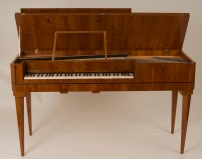Square piano by Kaspar Katholnig c1810
The squares of the Kaspar Katholnig workshop are perhaps the most numerous of all preserved pianos of the Viennese classical period. The different spellings of his name are comparably numerous, whether at the beginning with K- or C-, or at the end with -g, -gg, -k, or -ck.
Instruments like these are maybe the primary media of private music making in the era of Haydn, Beethoven or Schubert. The demand of such squares was so great that many workshops like Katholnig's specialised in these; there is, however, one grand by Katholnig extant, an instrument used by Johann Nepomuk Hummel as Haydn's successor as director of the Esterhazy orchestra.
The considerable output of square pianos led to a certain standardisation. The variability is less remarkable than with grand pianos, but they nevertheless represent the everyday music making based on the immense number of piano literature for private use far more than the grands for use in a semi-public or public environment.
After 1800 the importance of squares for domestic use even increased. Many composers with lesser financial means, like Franz Schubert and others, composed and played on a square like this. Insofar the seemingly restricted means of such instrument represent the real life situations of their age.
Our collection has two original Katholnig squares, one of which completely untouched and unrestored. This has become the model for our reconstruction, built by Helmut Balk and Markus Thiel. The yew veneer, resembling the model instrument, came from a yew alley in the Loire valley which had been cleared.
The unrestored original instrument is available for research purposes in an unaltered stage.
© Greifenberger Institut für Musikinstrumentenkunde | info@greifenberger-institut.de




